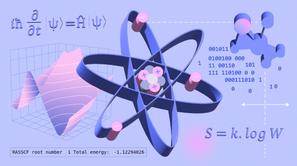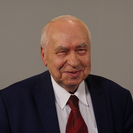Мой профиль

язык курса
длительность курса
понадобится для освоения
для зачета в своем вузе
за обучение
Dear learners, please note that only part of the materials is available for free viewing. All course materials will be available after certification payment.
Computational quantum chemistry is an important tool for studying chemical systems and reactions, and for the development of new materials and products.
We invite specialists and students in various fields of chemistry, physics, biology, materials science, and pharmacology to gain basic fundamental knowledge on the subject and skills on how to use computational quantum chemistry methods in their work.
What awaits you in the course?
By completing 10 modules of the course, you will learn how to use quantum chemistry methods and software to calculate the properties of chemical compounds and investigate the mechanisms of chemical reactions running the calculations either on a laptop or on supercomputers.
At the beginning of the course you will:
In the first part of the course you will learn how to:
In the second part of the course you will learn how to:
By completing the course, you will also be able to easily start using different other quantum chemistry programs such as Gaussian, NWChem, etc.
The form of education is online. Weekly classes will include watching thematic video lectures, studying additional materials and completing tests with automated verification of results. All assignments must be completed to obtain a certificate.
This course may be of interest to undergraduate, graduate and postgraduate students of higher education institutions, as well as to all those who are interested in this topic.
For potential employees, the course will provide science-based information that will give them a competitive advantage in their own employment.
Module 1a. Introduction. Wave function of hydrogen-like atoms. General principles of description of many-electron systems. The concept of an orbital.
Module 1b. Practice. Basics of working in Linux operating system. Installation and basic principles of using quantum chemical programs Molcas and ORCA.
Module 2. Molecular coordinate system. The concept of molecular orbital and the MO-LCAO method. Atomic basis sets.
Module 3a. Constructing a many-electron wave function from one-electron wave functions (orbitals). Basic approaches to solving the Schrödinger equation. Self-consistent field method. Restricted and unrestricted Hartree-Fock methods.
Module 3b. Practice. Calculation of the electronic energy of the hydrogen molecule. Calculation of the electronic energy of the triplet state for the hydrogen and oxygen molecules. Calculation of the dissociation energy of the hydrogen molecule. Using graphical programs to visualize the results of quantum chemical calculations.
Module 4a. Post-Hartree-Fock methods. Perturbation theory method (MP2) and coupled cluster method (CCSD(T)).
Module 4b. Practice. Calculation of the dissociation energy of the hydrogen fluoride molecule using post-Hartree-Fock ab initio methods (MP2, CCSD(T)).
*Module 5a. Configuration interaction methods - CIS, CISD, CISDT, CISDTQ. Full Configuration Interaction method (FCI). Multiconfigurational Self Consistent Field (MCSCF). CASSCF and CASPT2 methods.
*Module 5b. Practice. Calculation of the dissociation energy of the hydrogen fluoride molecule using post-Hartree-Fock ab initio methods (CISDT, CISDTQ, MCSCF, CASSCF, CASPT2).
Module 6a. The concept of electron density. Fundamentals of density functional theory methods (DFT). Electron-electron interaction. Types of electron correlation.
Module 6b. Practice. Calculation of dissociation energies of diatomic molecules using different density functionals.
Module 7a. The Born-Oppenheimer approximation. The concept of the potential energy surface.
Module 7b. Practice. Calculation of the potential energy surface for the hydrogen fluoride molecule using different ab initio and DFT methods.
Module 8a. Types of stationary points on the potential energy surface. Principles of calculation of gradients and Hessian matrices. Basic approaches to molecular geometry optimization.
Module 8b. Practice. Calculation of gradients and Hessian matrices, geometry optimization of various molecular systems using ORCA and Molcas programs.
Module 9.1a. Motion of nuclei near the equilibrium point. Vibrational spectra.
Module 9.1b. Practice. Calculation of transition energies between vibrational levels of diatomic and polyatomic molecules.
Module 9.2a. Macroscopic properties of ensembles of molecules. Gibbs energy, enthalpy, entropy.
Module 9.2.b. Practice. Calculation of enthalpy, entropy and Gibbs energy.
Module 9.3.a. Methods for taking into account solvent effects in quantum chemical calculations.
Module 9.3.b. Calculation of the difference in Gibbs energy and the relative stability of different forms of molecules in the gas phase and solvent.
Module 10a. Basic principles of modeling chemical reactions. Approaches to the optimization of transition states. The reaction path and the reaction coordinate.
Module 10b. Practice. Calculation of potential energy surface scans. Optimization of transition states. Calculating the reaction coordinate for a set of reactions in the gas phase and solvent.
*Modules marked with an asterisk are intended for in-depth study of the topic.
The discipline is aimed at the formation of universal competencies of students in the educational programs of the bachelor's / specialist's degree, as well as other competencies provided for by the educational program.
ПК-10 Владеет современными компьютерными технологиями, применяемыми при обработке результатов научных экспериментов и сборе, обработке, хранении и передачи информации при проведении самостоятельных научных исследований, свободно владеет ими при проведении самостоятельных научных исследований;
ПК-12 Умеет применять основные законы химии при обсуждении полученных результатов, в том числе с привлечением информационных баз данных;
ПК-4 Использует основные законы естественнонаучных дисциплин в профессиональной деятельности, применяет методы математического анализа и моделирования, теоретического и экспериментального исследования.
After completing the course you will know:
After completing the course you will learn how to:
After completing the course you will be proficient in:
язык курса
длительность курса
понадобится для освоения
для зачета в своем вузе
за обучение

Доктор химических наук
Должность: доцент Института Химии СПбГУ

Должность: научный сотрудник Санкт-Петербургского Политехнического Университета Петра Великого

Доктор физико-математических наук
Должность: профессор, зав. каф. Квантовой химии Института Химии СПбГУ
По данному курсу возможно получение сертификата.
Стоимость прохождения процедур оценки результатов обучения с идентификацией личности - 3600 Р.